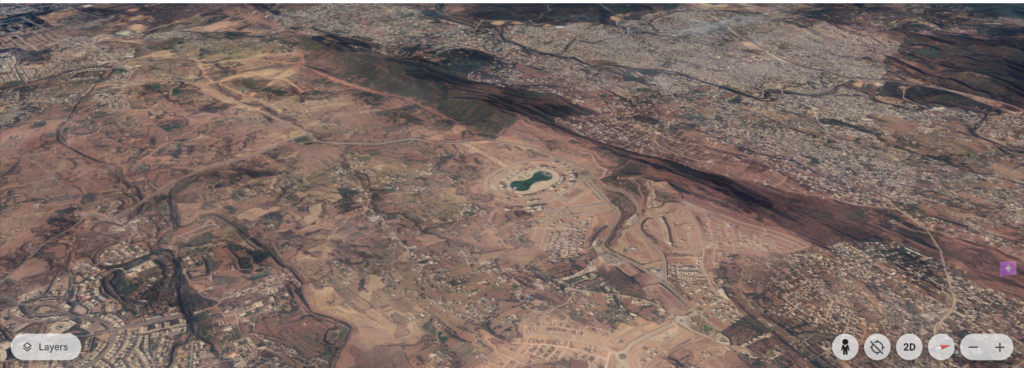By: Nouman Alam
Date: 18/04/2025
Islamabad, established in 1960, is a modern and planned city compared to other urban centres of Pakistan. Since replacing Karachi as the capital in 1963, Islamabad has grown rapidly, situated at the base of the Margalla Hills on the Potohar Plateau between 457 and 610 meters above sea level. Once surrounded by thick Himalayan forests, the city has seen its population swell from 117,000 in 1961 to over 2.4 million in 2023.
On April 16, 2025, Islamabad experienced a severe and unprecedented hailstorm that transformed the capital’s thoroughfares into hazardous, ice-covered zones. Marble-sized hailstones shattered car windows, damaged solar infrastructure, and uprooted trees, leaving residents stunned. While meteorologists linked the storm to shifting seasonal patterns and climate change, the event underscores a deeper truth: human-driven environmental degradation, particularly rampant deforestation and unchecked urbanization, has created conditions ripe for such disasters. Historical records show that Islamabad’s average temperature has already increased by 3°C between 1961 and 1990. Future projections are even more alarming: UN-Habitat estimates that temperatures will rise by 0.7°C by 2039 and by 2.2°C by 2069. This article explores how the destruction of Islamabad’s natural ecosystems and the city’s relentless concretization have amplified climate vulnerabilities, turning the capital into a ticking time bomb for future catastrophes.

The Hailstorm: A Symptom of a Larger Climate Breakdown
The April 16 storm was not an isolated incident but part of a pattern of extreme weather events plaguing Islamabad. The Pakistan Meteorological Department (PMD) warned that such anomalies, sudden hailstorms amid heatwaves are becoming frequent due to climate change. Senator Sherry Rehman, a climate advocate, labelled the storm “extreme weather volatility driven by climate change,” emphasizing its ties to human actions like fossil fuel dependence.
Key Impacts:
- Infrastructure Vulnerability: Renewable energy installations, particularly solar panels essential for sustainable power generation, sustained significant damage, highlighting the inadequate resilience of green infrastructure against extreme weather events.
- Hydrological Challenges: Severe flash flooding overwhelmed urban drainage systems in low-elevation areas, exposing critical deficiencies in the city’s water management infrastructure.
- Socioeconomic Consequences: The disaster imposed substantial financial burdens through widespread vehicle damage, extended power disruptions, and agricultural losses, depleting both public and private resources.
Deforestation and Urban Sprawl: Engineering a Climate Catastrophe
Islamabad’s transformation from a green haven into a sprawling concrete jungle has been both rapid and reckless. Over the past three decades, the city’s built-up area has expanded by an astonishing 585%, consuming forests, grasslands, and agricultural land in its path. According to research by WWF-Pakistan, tree cover in Islamabad declined from 28,060 hectares in 1990 to just 25,243 hectares in 2020. In the same period, housing societies, highways, and commercial developments steadily replaced the city’s once-thriving natural landscapes.
At the heart of this environmental degradation lies a toxic combination of greed and poor governance. Private housing societies, driven by profit, have often bypassed environmental feasibility studies, clearing ecologically sensitive areas to build luxury estates and gated communities. As highlighted by researcher Zeeshan Raees, Islamabad’s forest cover has dropped dramatically, from 19.3% to just 10.3%, contributing directly to rising temperatures, urban heat islands, and erratic rainfall patterns.
Government institutions have not only turned a blind eye but have actively enabled this destruction. The Capital Development Authority (CDA), responsible for regulating the city’s land use, has repeatedly failed to enforce zoning laws and environmental protections. The original Master Plan of 1960, which was meticulously designed to maintain a balance between urban development and ecological preservation, has been systematically violated, leaving Islamabad vulnerable to the climate extremes it now faces
According to a 2019 report by the Ministry of Climate Change, Pakistan has lost 9.6% of its forest cover over the past two decades, with urban centers like Islamabad leading this alarming trend. This deforestation, combined with unchecked urban sprawl, has not only stripped the city of its natural defences but also intensified the urban heat island effect. As concrete structures and asphalt surfaces absorb and retain heat, they raise local temperatures significantly compared to surrounding rural areas. In Islamabad’s case, this phenomenon has led to a 3°C increase in average temperature since 1961, disrupting the city’s thermal balance and creating conditions ripe for extreme weather events such as violent storms, heatwaves, and sudden hailstorms. These rising temperatures and climatic imbalances are no longer future threats, they are already reshaping daily life in the capital.

Climate Context: From Drought to Deluge
The hailstorm struck against a backdrop of alarming climatic shifts that have been intensifying in recent years. One of the most pressing concerns is the reduction in winter rains. Over the past two years, Islamabad has witnessed a significant decline in winter precipitation, leading to drought-like conditions and escalating water scarcity across the region. At the same time, erratic monsoon patterns driven by climate change have made rainfall increasingly unpredictable, swinging between extremes of flooding and prolonged dry spells. In 2022, for instance, Islamabad received a staggering 620 mm of rain in just 10 hours, flooding multiple sectors including E-11, marking a historic high in the city’s rainfall records.
Adding to this instability are temperature extremes. In April 2025, temperatures soared to an unbearable 45°C in parts of southern Pakistan, only to be followed by an abrupt drop in temperature. This sudden shift created the perfect atmospheric conditions for the violent hailstorm that struck Islamabad. These extreme weather events are not random, they are symptoms of a changing climate compounded by poor environmental governance.
The Looming Threat: Urban Flooding and Water Scarcity
If urbanization continues unabated, Islamabad faces a dystopian future marked by severe environmental challenges. One major threat is urban flooding. The rapid increase in impermeable surfaces such as roads, concrete structures, and parking lots prevents rainwater from being absorbed into the ground, drastically increasing surface runoff. The flash floods caused by the 2025 hailstorm are not isolated incidents, they are early warnings of far more destructive disasters waiting to unfold.
Another looming crisis is water stress. Islamabad’s groundwater levels have plummeted by an alarming 116 meters over the past 30 years. Meanwhile, the city’s daily water demand now exceeds supply by approximately 106 million gallons. With the population projected to reach 4.4 million by 2050, the pressure on already-scarce water resources will only intensify, turning water scarcity into a full-blown crisis.
The Path Forward: Reclaiming Resilience
To avert disaster, Islamabad must adopt urgent and strategic measures that prioritize environmental sustainability and climate resilience. Green urban planning should be at the forefront—this means enforcing strict land-use regulations, preserving existing green belts, and ensuring that all new infrastructure projects integrate climate-resilient designs. Equally important is reforestation. Restoring the natural vegetation of the Margalla Hills and reviving urban forests can play a crucial role in reducing the urban heat island effect and stabilizing local weather patterns.
The city must also invest in sustainable energy solutions, particularly by strengthening solar energy infrastructure to withstand extreme weather events like hailstorms and heatwaves. Lastly, public awareness is key. Educating both citizens and policymakers about the ecological interdependence of urban systems and natural ecosystems is essential to build a collective responsibility toward protecting Islamabad’s future.
Conclusion: A Call for Accountability and Action
The April 16 hailstorm serves as a critical warning signal. Islamabad’s influential stakeholders—both developers and policymakers—have consistently prioritized economic gains over environmental sustainability, effectively suppressing crucial discourse on ecological degradation. As Senator Rehman aptly cautions, Pakistan approaches a “water and agriculture emergency” of significant magnitude. Without comprehensive systemic reform, the capital faces an inevitable progression of escalating climate disasters, including severe urban flooding, devastating wildfires, and unprecedented heat waves. The era of performative environmentalism must end; only decisive, evidence-based interventions can restore Islamabad’s diminishing natural heritage and establish a sustainable foundation for future generations.
References
- Climate change and urbanization studies.
- PMD and NDMA weather alerts.
- Ecological surveys and stakeholder consultations.
